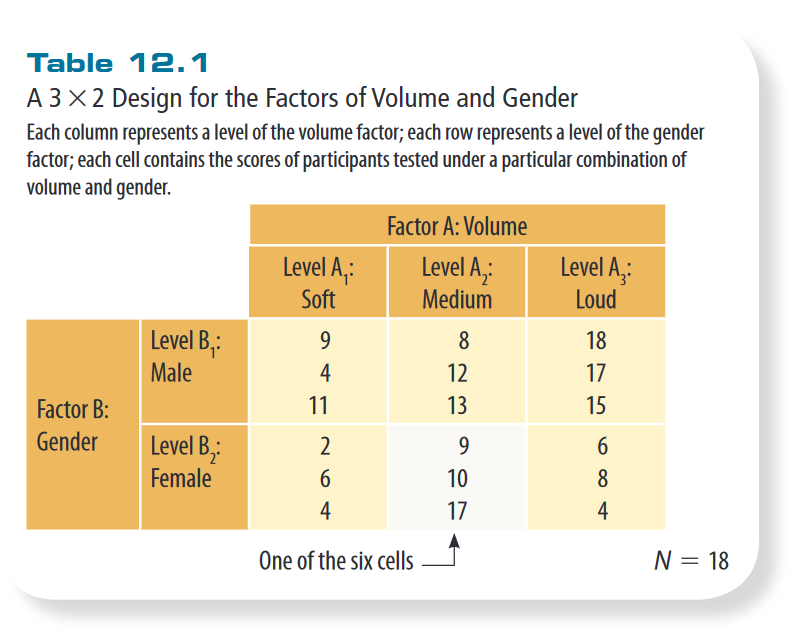Two-way ANOVA is mostly done via computers, not by hand. It is like one-way ANOVA, but involves two independent variables, rather than one. Not only do we look at the two main effects, but also the interaction effect.
It comes in three variations:
- two-way between-subjects ANOVA
- two-way within-subjects ANOVA
- two-way mixed-design ANOVA
This is how we set up this experiment. A cell is (e.g. 9,10,17; 3 people who were female and listened to something at medium volume).

To start, we calculate one-way ANOVA for the columns. Then the rows.
Finally, we calculate the interaction. To do this, we look at “cell means” e.g. the means of each individual cell.
This results in the following output:
| Source | Sum of Squares | df | mean square | F |
|---|---|---|---|---|
| Between | ||||
| - Factor A (volume) | 117.45 | 2 | 58.73 | 7.14 |
| - Factor B (gender) | 93.39 | 1 | 93.39 | 11.36 |
| - Interaction (vol x gen) | 102.77 | 2 | 51.39 | 6.25 |
| Within | 98.67 | 12 | 8.22 | |
| Total | 412.28 | 17 |
Sum of squares isn’t sum(x^2), but rather the sum of the deviation squared. In excel, that’s calculating how each individual data point compares to the overall mean. Squaring that value and then summing it along some factor.
In some stats software “Within” in the table above is called “error” b/c it tracks the differences among scores within each cell.
We can see the Effect size (percentage of the differences accountated for by a given factor) with
It can be quite helpful to understand the interaction effect through graphings. The depenent variable is the y-axis, factor 1 is the x and there’s a line for each of factor 2. The data point is the cell mean. If the lines are parallel, there’s no interaction effect.
When conducting the tukey HSD test, we compare each cell along vertical or horizontal axes. Not diagonal (b/c they differ on more than one factor at a time). Doing this (which, again, is wrong) is called a “confounded comparison”. The needs to use an “adjusted k”, which we can look up in a table called “Values of Adjusted k” based on how many factors/factor groups are involved.
The df of the interaction is ().
Definitions
mixed-design : meaning one factor is between-subjects and the other is within-subjects
cell (two-way ANOVA) : the combination of one level of one factor with one level of another factor
factorial design : all levels of one factor are combined with all levels of the other factor
main effect : the overall effect of changing a particular factor has on the dependent scores when we collapse the other factors.
collapsing : It really just means “ignoring the other factors” for the purpose of calculating “main effect means”.
cell mean : the mean of the scores from one cell in a two-way design
two-way interaction effect : the influence one factor has on scores depends on which level of the other factor is present.
confounded comparison : comparing two cells that differ along more than one factor
unconfounded comparison : comparing two cells that differ along only one factor